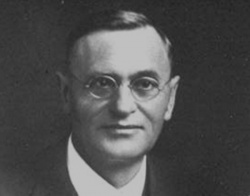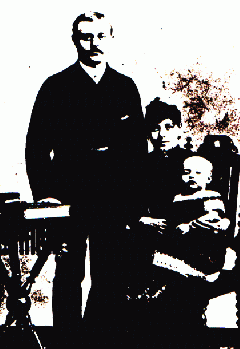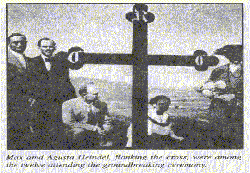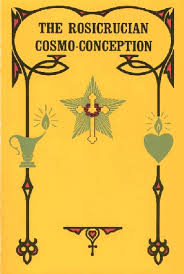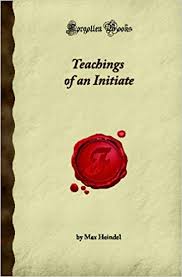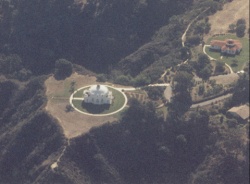Max Heindel
Max Heindel (born Carl Louis von Grasshoff, July 23, 1865 – January 6, 1919) was a Danish-American Christian occultist, astrologer, and mystic. He is the founder of The Rosicrucian Fellowship and the author of several books spreading the teachings of Esoteric Christianity.
Personal Life
Max Heindel was born as Carl Louis von Grasshoff on July 23rd, 1865, in Aarhus, Denmark. His father, Francois L. von Grasshoff, who was born in 1838 in Berlin, Germany, migrated as a young man to Denmark, where he married Anna Sorine Withen, a Danish woman and the daughter of the clog maker Chresten Petersen Bregnetfeld and his wife, Mette Kirstine Petersen. He probably came to Denmark with the Prussian army during the Dano-German war in 1864. They had a daughter and two sons, of which the oldest was Carl Louis Fredrik Grasshoff, who later adopted the pen name Max Heindel.[1] [2]
The father died when the eldest son was six and the mother was left with her three small children in very strained circumstances. Eventually they left Aarhus and moved to the Frederiksberg section of Copenhagen. Soon after, eight-year-old Carl had an accident and twisted his left foot badly. Because of this injury, he was confined to bed for sixteen months. Surgeons took out several splinters of bone, bored through the ankle, and inserted into the foot several tubes to drain the enormous amount of pus that was continually building up. He suffered for a very long time because of the injury since there was a large open sore that did not heal. Only thirty years later, six months after following a strict vegetarian diet when he joined the Theosophical Society, did that wound finally heal.[3][4]
Since life at home did not satisfy Carl Grasshoff, he decided to leave his family and sailed to Glasgow at the age of sixteen. He first found a job as a master tobacconist[5] and then entered the ship-yards at Glasgow, Scotland, where he learned the engineering profession.[6][7] He met his future wife, Catherine Dorothy Luetjens Wallace, in Glasgow and married the 16-year-old girl at the age of 20 on December 15, 1885. They had three daughters between 1886 and 1889 and a son in 1891. During this time his mother met her second husband, Fritz Nicolaj Povelsen, whom she married on June 15, 1886.[8][9] Max Heindel’s marriage was not a happy one[10] and around 1896 he emigrated alone to the U.S.A. and changed at this point his name to Max Heindel. His wife stayed in Copenhagen and his four children remained in the care of their grandmother.[11] Max Heindel worked as an engineer in a brewery in Somerville near Boston, MA. Around 1897 he married a Danish woman named Peterson who had four children of her own. In 1898 Max Heindel’s children followed him from Copenhagen to the U.S.A. and after his divorce from his second wife he moved with them to Roxbury, a suburb of Boston, Ma.[12]
He found Theosophy in 1904. Later he became a Rosicrucian and started writing his first book, which he published in 1909. In August 1910, he was joined in marriage to Augusta Foss. His field of his work increased after the publication of his first book and he and his wife established a Headquarters for the purpose of disseminating the Rosicrucian Philosophy. For the first eight months they lived in Ocean Park, California. Later they moved permanently to Oceanside, California.[13]
Max Heindel passed away on January 6th 1919 at the age of 53 in Oceanside, California.[14]
Involvement with the Theosophical Society
Max Heindel came to Los Angeles, California in 1903 where he worked as an engineer for a time. In December of that year he became interested in metaphysics and attended lectures by Charles Webster Leadbeater. Heindel was admitted as a member of the Theosophical Society on March 9, 1904 in the Harmony Lodge of Los Angeles.[15] While connected with the TS he became friends with Augusta Foss, who became in Max Heindel’s word his “spiritual inspiration”, who helped him find work and was instrumental in interesting him in the science of astrology.[16] He was vice-president of the Theosophical Society in Los Angeles from 1904 until 1905.[17]
In a letter addressed to Leadbeater, Heindel wrote that Leadbeater’s statement that “every man had in him clairvoyant abilities” prompted him to attend one of his lectures. He sneered at Leadbeater’s statement that psychic abilities can never be used for selfish purposes. But when he read Annie Besant’s Karma and Reincarnation he understood why “occult powers must be used reverently as a help to humanity and not for personal gain”. That’s when he saw that he had a place in this great cosmic scheme and started to devour Theosophical writings. He stopped drinking, smoking, and lying, and started to control his thoughts. He also expressed his gratitude to Leadbeater in the same letter.[18]
During the summer of 1905 Max Heindel had serious heart trouble, but whenever health permitted, he went on the lecture platform to spread his occult knowledge.[19]Albeit, he withdrew from the Theosophical Society in 1905 after he had made the acquaintance of Alma von Brandeis who convinced him to go to Berlin to meet a man whom she claimed to be a most wonderful lecturer and teacher. This man was Dr. Rudolf Steiner, who became in 1902 the head of the “German Theosophical Society”.
Even after he had left the Theosophical Society, he still gave lectures. He was in June 1907 in Minneapolis delivering eight stereopticon lectures which were well attended and at the close of the visit a study class was formed. The lectures were described appealing “to the eye and ear”. [20]He gave a series of public lectures in the Butte Lodge followed by discussions which were attended by 100 to 300 people. [21]He gave another series of lectures some time later at the same branch. Among the topics were “The Astronomical Basis of Religion”, “Parsifal”, “Riddle of Life and Death”, and “Life in Heaven”. [22]His free and public lectures at the Superior Branch in Wisconsin were “well received”.[23]His free lectures were always well regarded and considered “striking” and the use of magic-lanterns as “unique”.[24]
Max Heindel in Germany
Alma von Brandeis and Max Heindel both travelled to Germany in November 1907. Max Heindel’s goal was to intensively study the teachings of Rudolf Steiner. Steiner, although a representative of the Theosophical Society of Adyar in Germany, claimed to be a Rosicrucian. This was the reason why Heindel, again under his real name Grasshoff, had come to Germany. Heindel visited the meetings, took part in both sections of Steiner’s Esoteric School and had a few meetings with Steiner.
Alma von Brandis had joined Steiner’s group in 1906. She wanted to persuade Heindel to become a messenger of Steiner’s teachings in the United States. Heindel in turn had hoped that Steiner would be able to help him to advance along the path of spiritual development but was disappointed and wanted to return to the States which lead to a permanent split with von Brandeis.[25]
Rosicrucianism
According to Max Heindel himself he was contacted by an Elder Brother of the Rosicrucians in April and May 1908 in Germany. After passing a test, he had his first initiation which was followed by more initiations in the United States. According to other sources he was introduced at that time to Rosicrucianism by Franz Hartmann, a German Theosophist and Rosicrucian.[26]
Heindel drafted in German, while still in Germany, a manuscript which was according to him based on the information he received from this Rosicrucian teacher. He also said that he was told that this manuscript would not satisfy him when he reached the U.S.A and that he would wish to rewrite the entire book. This he did and published in 1909 in the U.S.A. The Rosicrucian Cosmo-Conception.[27]The Rosicrucian Fellowship was launched during the late summer and autumn of 1909, after a course of lectures in Seattle by Mr. Max Heindel. A study center was formed, and the headquarters temporarily located in that city. Max Heindel also said: “At the dismissing from the Temple, the Elder Brothers gave me the following parting admonition and counsel: never try to attract money, not even to build the Ecclesia or Sanitarium. Buildings are dead, no matter how beautiful, so aim rather to interest men and women of noble souls, that this movement may be endowed with their life, for only thus can it become a living factor in the world’s work. If you adhere to this policy, buildings of commensurate dignity will come in time, as required by the work; but, if ever you make these priceless Teachings subservient to Mammon, the light will fade and the movement will fail.”[28]
The Steiner/Heindel Controversy
When Heindel met Rudolf Steiner, he mentioned that he was writing a book and according to Heindel, Steiner said that this was not a problem as long as he mentioned his name in the book. Even though he had included the teachings of the Elder Brothers, the book corroborated the teachings of Dr. Steiner along main lines, and Heindel thought it was better to dedicate the book to Steiner than appear to be a plagiarist.[29] Max Heindel wrote in his dedication of the first edition that he received much valuable information from Steiner, but the more far-reaching body of Teachings contained in the Cosmo originated from the Elder Brother.[30]
However, Steiner commented as follows in one of his lectures about Heindel:
"In his books he then called himself Max Heindel, but here he had another name, calling himself Grasshof. This man had here taken up all that he could from lectures and books. Out of that he had made, some what mystical, a book, Rosicrucian Cosmo Conception and then in a second edition he also had taken up all that can be read in the lecture cycles and what else he had copied. Then he had told his people over there in America that he had taken up the first stage here, but that to reach the second stage, he had gone to a Master in Hungary.'
'From him he stated that he had got what he only had copied from the cycles and especially from all the lectures that he cunningly (?) had found and of which his writing were a pure case of plagiarism! Some of you will know that also the very comical thing happened, that this thing was translated back into German, with the remark that it admittedly was possible to have something similar also in Europe, but that it was better to get it in the form in which it could arise under the free sun of America.”[31][32]
It is true, that the Rosicrucian Cosmo-Conception reads similar to the basic works and lectures by Steiner, but the same could be said for Theosophical writings. Even so, Heindel spent only a few months in Europe and was not interested in Anthroposophy but mainly in Rosicrucianism after leaving the Theosophical Society.
Heindel wrote in his book “Teachings of an Initiate” that he was not awakened in his inner soul when he met Steiner and began his initiatory work when he was about to leave Germany. He passed a test, was initiated and received teachings.[33]
He was only told at a later point that the Elder Brother’s first choice for candidate was Dr. Rudolf Steiner, who had been under their instruction for several years but had failed to pass his test because he could not be a leader of both the Western Teachings as well as the Eastern Teachings. He was further told that the Teachings had to be published before the close of the first decade.[34][35]
Even when he published later works, for example Gleanings of a Mystic, one of his last books, he was criticized for not acknowledging his sources as well as for the writings being in “a more popular, easy intelligible, spicy, and sensational form.”[36]
After publishing the Rosicrucian Cosmo-Conception Heindel had no more contact with Steiner and wrote other original material. In the preface to the second edition of the Cosmo Conception, Heindel clarified why he dedicated the first edition to Steiner and then withdrew this dedication in the second edition.
All we can do is find our own truth and see if it is supported by others. Many occult students use both sources and find Heindel's work greatly clarifies Steiner work and that Steiner greatly enriches Heindel's. Heindel initially respected Steiner but chose a path Steiner rejected. The similarities are due to a common source to both men.[37]Both started as Theosophists and had Rosicrucian teachers. It is also said that his “occult intimations reached him through the kind of clairvoyance, which is termed reading in the Akashic Records, otherwise the Astral Light by Éliphas Lévi Zahed”. After Theosophy and Rudolf Steiner, he “took an independent line as the result of those occult investigations”.[38]
There are not only similarities but also differences between the teachings.[39]One example is the approach to breathing. Whereas Steiner explains that the Rosicrucian pupil gets specific instructions and has to breathe in a certain way, in a certain rhythm and with very definite thought forms for transformation[40], Heindel warns against the danger of doing breathing exercises to foster spiritual advancement.[41] Furthermore, Heindel writes about the tenfold constitution of the earth, whereas Steiner describes a nine-fold constitution.[42]
Final Remarks
If one reads The Secret Doctrine (book) and The Rosicrucian Cosmo-Conception or studies the lectures by Rudolf Steiner he will find many similarities while addressing the same topics. However, the big difference between Heindel and Theosophy is the emphasis on the superiority of Christianity.
“It is idolatry when people of the West take up the Eastern religions. Hinduism, Buddhism, and kindred teaching. For in the Aryan Epoch, only the Aryan Religions, the religions of the Lamb, have the proper effect on the human evolution. All previous systems are detrimental to the Western people; an in time those also who are now in the East, the Orientals, will be forced to embrace the religion, or be left far behind in evolution.”[43]
In other of Heindel’s works we find references to the Jews:
“Atlantis was the home of the Bull, Taurus, and when the Sun, by precession, was leaving that sign the last time, the Religion of the Lamb Aries was definitely ushered in. Thenceforth, the worship of the Bull was abrogated and when any of the pioneer race, brought out from the ancient Atlantean dispensations by the blood of the Lamb, Aries, backslid and worshipped the Taurean “Calf”, they acted contrary to the law of progress and were therefore “Idolators”, and an abomination to the divine hierarchs whose task it was to guide them during the ages preceding the advent of Christ. On account of repeated transgressions many were "lost", and they are the Jews of today. [44]In The Rosicrucian Cosmo-Conception he writes: The rebellious ones who were abandoned are the Jews, of whom the great majority are still governed more by the Atlantean faculty of Cunning than by Reason. In them the race-feeling is so strong that they distinguish only two classes of people: Jews and Gentiles. They despise the other nations and are in turn despised by them for their cunning, selfishness and avarice. It is not denied that they give to charity, but it is principally, if not exclusively, among their own people.”[45]
Max Heindel was a great admirer of Madame Blavatsky. He saw in her his own future struggles and had the desire to give to the world his greater knowledge which he had acquired, knowing that his years were numbered and that his physical body could not long stand the strain of the pioneer life. Like Madame Blavatsky he was in constant physical pain and in great need of help, both physical and financial.[46]
Manly Palmer Hall addressed the work of H.P.B. and Heindel in the Wizards Bookshelf Edition to Max Heindel’s book Blavatsky and the Secret Doctrine:
Both H.P Blavatsky and Max Heindel gave their lives in a beautiful service to the spiritual needs of the race. Both went to early graves, broken by responsibility and persecution. Each has left us a legacy to unborn generations a metaphysical literature which shall survive the vicissitudes of time.[47][48]
The Rosicrucian Fellowship founded in 1909 by Max Heindel exists to this day. On its website we can read that the “Fellowship is composed of men and women who study the Rosicrucian Philosophy known as the Western Wisdom Teachings as presented in The Rosicrucian Cosmo-Conception. This Christian Mystic Philosophy presents deep insights into the Christian Mysteries and establishes a meeting ground for Art, Religion, and Science. The work of the Rosicrucian Fellowship is to spread the gospel and heal the sick. This is achieved by making the Western Wisdom Teachings available to all who are willing to receive them, by providing a Healing Department which emphasizes spiritual healing along the principles of right living, and by making The Rosicrucian Fellowship books and home study courses available upon request.”[49]
Writings
The Union Index of Theosophical Periodicals lists 9 articles by or about Max Heindel. In addition he wrote numerous books:
- The Rosicrucian Cosmo-Conception, [1] [2] (1911 ed.) [3] (1920 ed.)
- The Rosicrucian Christianity Lectures [4]
- The Rosicrucian Philosophy in Questions and Answers - Volume I [5] [6]
- The Rosicrucian Philosophy in Questions and Answers - Volume II [7] [8]
- The Rosicrucian Mysteries [9] [10] [11]
- Letters to Students [12]
- Gleanings of a Mystic [13] [14]
- Mysteries of the Great Operas [15] [16]
- Teachings of an Initiate [17]
- Ancient and Modern Initiation [18]
- The Web of Destiny [19] [20]
- Freemasonry and Catholicism [21] [22] [23]
- The Vital Body [24]
- The Desire Body [25]
- The Rosicrucian Principles of Child Training [26]
- How Shall We Know Christ at His Coming? [27] [28]
- The Mystical Interpretation of Christmas [29] [30]
- The Mystical Interpretation of Easter [31]
- Nature Spirits and Nature Forces [32]
- The Message of the Stars [33] [34]
- Simplified Scientific Astrology www [35]
- Astro-Diagnosis - A Guide to Healing [36]
- Occult Principles of Health and Healing [37]
- Helena Petrovna Blavatsky and The Secret Doctrine, from his 1905/6 lectures (edited 1933; Introduction by Manly Palmer Hall) [38], an addendum
Additional resources
Articles
- Birth of the Rosicrucian Fellowship at Rosicrucian.com.
- Chronology about Max Heindel and the Rosicrucian Fellowship at Mount Ecclesia.Tripod.com
- Gleanings of a Mystic in Occult Review 42 no.3 (September 1925).
- Heindel and Steiner by Jeff Auen.
- The Max Heindel - Rudolf Steiner Connection, Controversy and Resolution compiled from several sources.
- Important Differences in the Teachings of Heindel and Steiner at Fraternidaderosacruz.org.
- Max Heindel in Germany
- Max Heindel: Messenger of the Rosicrucians
- Max Heindel, a Short Biography
- Heindel, Max in Theosophy World,
Horoscopes
- Max Heindel Natal Horoscope at Khaldea.
Websites
Notes
- ↑ [ http://rosicrucianzine.tripod.com/max_heindel.htm. Max Heindel – A Short Biography]. Accessed on 3/7/2019.
- ↑ Max Heindel. H.P. Blavatsky and The Secret Doctrine. San Diego, Ca.: Wizards Bookshelf, 19.
- ↑ Max Heindel – A Short Biography. Accessed on 3/7/2019.
- ↑ G. Westenberg, "Chronology about Max Heindel and the Rosicrucian Fellowship". Accessed on 3/20/2019.
- ↑ Max Heindel – A Short Biography. Accessed on 3/7/2019.
- ↑ Max Heindel, H.P. Blavatsky and The Secret Doctrine. San Diego, Ca.: Wizards Bookshelf, 20.
- ↑ Mrs. Max Heindel, Birth of the Rosicrucian Fellowship. Accessed on 3/20/2019.
- ↑ Max Heindel – A Short Biography. Accessed on 3/7/2019.
- ↑ Westenberg, G. "Chronology about Max Heindel and the Rosicrucian Fellowship". Accessed on 3/7/2019.
- ↑ Max Heindel, H.P. Blavatsky and The Secret Doctrine. San Diego, Ca.: Wizards Bookshelf, 20.
- ↑ Max Heindel – A Short Biography. Accessed on 3/7/2019.
- ↑ G. Westenberg, "Chronology about Max Heindel and the Rosicrucian Fellowship". Accessed on 3/20/2019.
- ↑ Max Heindel – A Short Biography. Accessed on 6/17/19).
- ↑ https://rosicrucianzine.tripod.com/max_heindel.htm. Max Heindel – A Short Biography]. Accessed on 6/27/2019.
- ↑ Theosophical Society General Membership Register, 1875-1942 at http://tsmembers.org/. See book 1, entry 25315 (website file: 2C/51).
- ↑ Max Heindel. H.P. Blavatsky and The Secret Doctrine”. Wizards Bookshelf, San Diego, Ca., p. 21
- ↑ Westenberg, G. Chronology about Max Heindel and the Rosicrucian Fellowship. http://mount_ecclesia.tripod.com/chronology_about_max_heindel.htm. Accessed on 3/20/2019
- ↑ Heindel, M. Letter to C.W. Leadbeater on 1/15/1904. Published in The Theosophist 1879, continuing, Bombay, and Adyar, HPB. April 1949, Vol. 70, p. 17 “How Max Heindel Came to Theosophy
- ↑ Mrs. Max Heindel, Birth of the Rusicrucian Fellowship. http://www.rosicrucian.com/pdf_plaza/Birth%20of%20the%20RF.pdf. Accessed on 3/20/2019
- ↑ Lecture in Minneapolis. Theosophic Messenger 8.12. Sep. 1907, page 200
- ↑ Terrel, Emily. Butte Lodge. Theosophic Messenger 9.6. March 1908, page 133
- ↑ Terrel, Emily. Butte Lodge. Theosophic Messenger 10.11. August 1909, page 530
- ↑ Somerville, Mary. Superior Branch. Theosophic Messenger 9.5. February 1908, page 109
- ↑ Lectures in Northwest. Theosophic Messenger 9.1. October 1907, page 14.
- ↑ Westenberg, G. Max Heindel and the Rosicrucian Fellowship. Chapter 4: Heindel in Germany. https://rffriends.org/wpx/wp-content/uploads/2009/10/Microsoft-Word-Chapter-4-Heindel-in-Germany.pdf Accessed on 3/9/2019. Page 61
- ↑ Norbert Klatt: Theosophie und Anthroposophie. Neue Aspekte zu ihrer Geschichte. Aus dem Nachlaß von Wilhelm Hübbe-Schleiden. Norbert Klatt Verlag, Göttingen. 1993. Page 111, footnote 423
- ↑ Westenberg, G. Max Heindel and the Rosicrucian Fellowship. Chapter 5: Messenger of the Rusicrucians. https://rffriends.org/wpx/wp-content/uploads/2009/10/Microsoft-Word-Chapter-5-Messenger-of-the-Rosicrucians.pdf Accessed on 3/9/2019. Page 69 ff.
- ↑ Short Historical Notes on the Rosicrucian Fellowship. http://www.rosicrucian.com/shn/shneng01.htm. Accecced on 5/17/19.
- ↑ Westenberg, G. Max Heindel and the Rosicrucian Fellowship. Chapter 4: Heindel in Germany. https://rffriends.org/wpx/wp-content/uploads/2009/10/Microsoft-Word-Chapter-4-Heindel-in-Germany.pdf Accessed on 3/9/2019
- ↑ Westenberg, G. Heindel-Steiner-Connection. http://www.fraternidaderosacruz.org/Heindel-Steiner_resolution.htm Accessed on 5/16/2019
- ↑ Westenberg, G. Heindel-Steiner-Connection. http://www.fraternidaderosacruz.org/Heindel-Steiner_resolution.htm Accessed on 5/16/2019
- ↑ Steiner, Rudolf. FA 203, Dornach, March 28th, 1921. http://fvn-rs.net/index.php?option=com_content&view=article&id=4469:siebzehnter-vortrag-dornach-28-maerz-1921&catid=306:ga-203-die-verantwortung-des-menschen-fuer-die-welt&Itemid=4. Accessed on 5/16/2019.
- ↑ Heindel, Max. Teachings of an Initiate. Oceanside, CA: 1955, pp. 100-102
- ↑ Westenberg, G. Max Heindel and the Rosicrucian Fellowship. Chapter 4: Heindel in Germany. https://rffriends.org/wpx/wp-content/uploads/2009/10/Microsoft-Word-Chapter-4-Heindel-in-Germany.pdf Accessed on 5/16/2019
- ↑ Heindel, Max. The Message of the Stars. The Rosicrucian Fellowship, Oceanside, Ca., 1976.
- ↑ Starr, Meredith. “Gleanings of a Mystic” Occult Review. Vol. 42, Nr. 3. Sept. 1925, p. 197. http://www.iapsop.com/archive/materials/occult_review/occult_review_v42_n3_sep_1925.pdf Accessed 6/15/2019
- ↑ Auen, Jeff. Heindel and Steiner. http://theaquarianage.tripod.com/ja_heindelsteiner.htm. Accessed on 6/15/19
- ↑ Occult Review. V29, N. 5. May 1919. http://www.iapsop.com/archive/materials/occult_review/occult_review_v29_n5_may_1919.pdf. Accessed 6/16/19.
- ↑ Westenberg, G. Important Differences in the Teachings of Heindel and Steiner. http://www.fraternidaderosacruz.org/Important-differences-in-the-teachings-of-Steiner-and-Heindel.pdf. Accessed on 3/10/2019
- ↑ R. Steiner, Die Erkenntnis der Übersinnlichen in unserer Zeit und deren Bedeutung für das heutige Leben. Dornach: Rudolf Steiner Verlag, 1959, p. 199 [GA 55]
- ↑ Heindel, Max. The Rosicrucian Christianity Lectures. Chicago: M. A. Donahue & Co., 1909, pp. 174-176
- ↑ Westenberg, G. Important Differences in the Teachings of Heindel and Steiner. Page 268. http://www.fraternidaderosacruz.org/Important-differences-in-the-teachings-of-Steiner-and-Heindel.pdf. Accessed on 5/16/2019.
- ↑ Max Heindel. The Message of the Stars. The Rosicrucian Fellowship. Oceanside, Ca. 1976. Page 24
- ↑ Max Heindel. The Message of the Stars. The Rosicrucian Fellowship. Oceanside, Ca. 1976. Page 19
- ↑ Heindel, Max. The Rosicrucian Cosmo-Conception. The Rosicrucian Fellowship. 1998. Page 310.
- ↑ Max Heindel. A Short Biography. http://rosicrucianzine.tripod.com/max_heindel.htm. Accessed on 6/17/19).
- ↑ Hall, Manly. Introduction to Max Heindel's book Blavatsky and The Secret Doctrine, 1933. Wizards Bookshelf, San Diego, Ca., p. 10
- ↑ Review. Eclectic Theosophist. Jan.-Feb. 1991, page 8-9
- ↑ The Rosicrucian Teachings. The Rosicrucian Fellowship. http://www.rosicrucian.com/index.html. Accessed on 5/17/19
